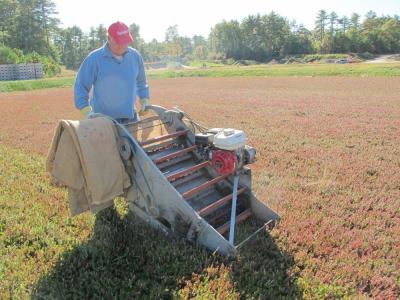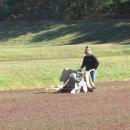Hartley family cranberry harvest bogged by drought
ROCHESTER – Fast winds howled over the Hartley-Rhodes cranberry bogs on a sunny day on Oct. 20 as Selectman Woody Hartley prepared for the dry harvest.
“Haven’t checked them out yet,” he said, looking out over the bright crimson-colored fields, “but it’s so windy that they should be nice and dry.”
The Hartley family has eight bogs — four wet ones and four dry ones — for harvest. Hartley and his brother pushed pickers across the fields, and later in the day, Hartley’s son, Scott, would come to join them.
From the bogs, one can see the homes of Hartley, his sister, and their grandmother.
Hartley and his brother first bought the land from their parents 30 years ago with the idea to build sustainable cranberry bogs, but his family only started dry picking about nine years ago.
“We thought our families could make a little money off this land every year instead of just selling it,” he said.
They keep the operation sustainable by using their own pond water rather than drawing from the Sippican River.
“Our wives come down and help once we get all the bags full,” he said, pointing to sacks full of cranberries. “And some of my grandkids come down and they’ll hop in the truck and ride around.”
The entire dry harvest takes twelve hours, spread out over 4 days because the bogs have to be dry.
“If you wake up in the morning and there’s dew on ‘em, you have to wait,” he said.
At the end of the harvest, they can have anywhere between 15,000 and 2,000 barrels, “depending on how good they are.”
Because of this year’s drought, Hartley says that this year’s harvest hasn’t been very good thus far. During their wet harvest, they found that around half the cranberries were orange and soft, meaning that they were rotten.
“In a drought, we have to irrigate,” he said.
Using irrigation instead of relying on natural rain makes many cranberries wetter than they should be, resulting in more casualties.
Hartley anticipates that plenty of orange cranberries will show up in their dry harvest, too.
Wet cranberries are generally harvested for juices and sauces, while dried cranberries are sold fresh for consumers to use in sauces, pies, stuffing, or as decoration.
The separator that Hartley uses to sort the good cranberries from the bad ones is over 100 years old.
The Hartleys pour the cranberries in the separator, which blows out the excess leaves. Then, the cranberries go up a miniature elevator and fall onto a board. If they bounce over the lip, they’re ripe and ready.
If the cranberries don’t bounce, they go into a box that Hartley calls “seconds.” In that box, they have more time to ripen and another chance to go through the machine.
Like cement gets hotter and hotter, Hartley said, cranberries get redder and redder.
When the cranberries have gone through the separator, the Hartleys go through the cranberries one by one and check them for bug damage before sending “the perfect ones” off to be sold.
The operation that starts locally stays that way, and the family sells their cranberries at farmers markets and small businesses, such as Fieldstone Market, where those in the community can then enjoy the fruits of the Hartley family’s labors.




















